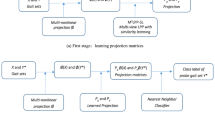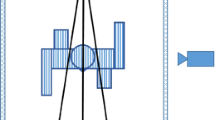Abstract
Graph-Embedding is a widely used learning technique in pattern recognition. However, it is difficult to construct an inter-view graph for cross-view gait samples. To remedy it, in this paper, we propose a novel cross-view gait recognition algorithm named Graph-optimized Coupled Discriminant Projections (GoCDP), which seeks coupled projections based on adaptive graph learning. Regarding the embedding graphs as variables rather than predefined constants, we integrate inter-view graph construction with projection optimization process into a unified framework. By an alternate iteration algorithm, we can ultimately obtain the optimal coupled projections. Moreover, we extend GoCDP to multi-view case called Graph-optimized Multiview Discriminant Projections (GoMDP) for multi-view subspace learning. Experimental results on two benchmark gait datasets, CASIA-B and OU-ISIR, demonstrate the effectiveness of the proposed methods.







Similar content being viewed by others
References
Bashir K, Xiang T, Gong S (2010) Cross-view gait recognition using correlation strength. pp 1–11
Bashir K, Xiang T, Gong S (2010) Gait recognition using gait entropy image. In: International conference on crime detection and prevention
Ben X, Gong C, Zhang P, Jia X, Wu Q, Meng W (2019) Coupled patch alignment for matching cross-view gaits. IEEE Trans Image Process PP(6):1–1
Ben X, Gong C, Zhang P, Yan R, Wu Q, Meng W (2020) Coupled bilinear discriminant projection for cross-view gait recognition. IEEE Trans Circ Syst Vid Technol :734–747
Chen X, Yang TQ (2014) Cross-view gait recognition in 3-d space based on gravity center track. Appl Mech Mater :4210–4215
Han J, Bhanu B (2006) Individual recognition using gait energy image. IEEE Trans Pattern Anal Mach Intell 28(2):316–322
He X, Niyogi P (2003) Locality preserving projections. pp 153–160
He Y, Zhang J, Shan H, Wang L (2019) Multi-task gans for view-specific feature learning in gait recognition. IEEE Trans Inf Forensics and Secur 14(1):102–113
Hu M, Wang Y, Zhang Z, Little JJ, Huang D (2013) View-invariant discriminative projection for multi-view gait-based human identification. IEEE Trans Inf Forensics Secur 8(12):2034–2045
Iwama H, Okumura M, Makihara Y, Yagi Y (2012) The ou-isir gait database comprising the large population dataset and performance evaluation of gait recognition. IEEE Trans Inf Forensics Secur 7 (5):1511–1521
Jean F, Bergevin R, Albu AB (2009) Computing and evaluating view-normalized body part trajectories. Image Vis Comput 27(9):1272–1284
Jun K, Lee DW, Lee K, Lee S, Kim MS (2020) Feature extraction using an rnn autoencoder for skeleton-based abnormal gait recognition. IEEE Access PP(99):1–1
Kusakunniran W, Wu Q, Zhang J, Li H (2012) Gait recognition under various viewing angles based on correlated motion regression. IEEE Trans Circ Syst Vid Technol 22:966–980. https://doi.org/10.1109/TCSVT.2012.2186744
Lam THW, Cheung K, Liu JNK (2011) Gait flow image. Pattern Recogn 44(4):973–987
Liao R, Yu S, An W, Huang Y (2020) A model-based gait recognition method with body pose and human prior knowledge. Pattern Recogn 98:107069
Luo J, Tang J, Tjahjadi T, Xiao X (2016) Robust arbitrary view gait recognition based on parametric 3d human body reconstruction and virtual posture synthesis. Pattern Recogn 60:361–377
Makihara Y, Sagawa R, Mukaigawa Y, Echigo T, Yagi Y (2006) Gait recognition using a view transformation model in the frequency domain. pp 151–163
Makihara Y, Suzuki A, Muramatsu D, Li X, Yagi Y (2017) Joint intensity and spatial metric learning for robust gait recognition. In: Computer vision and pattern recognition
Mansur A, Makihara Y, Muramatsu D, Yagi Y (2014) Cross-view gait recognition using view-dependent discriminative analysis. In: IEEE International joint conference on biometrics
Raducanu B, Dornaika F (2012) A supervised non-linear dimensionality reduction approach for manifold learning. Pattern Recogn 45(6):2432–2444
Rida I, Almaadeed N, Almaadeed S (2019) Robust gait recognition: a comprehensive survey. IET Biom
Takemura N, Makihara Y, Muramatsu D, Echigo T, Yagi Y (2019) On input/output architectures for convolutional neural network-based cross-view gait recognition. IEEE Trans Circ Syst Vid Technol 29(9):2708–2719
Wang C, Zhang J, Pu J, Yuan X, Wang L (2010) Chrono-gait image: a novel temporal template for gait recognition. pp 257–270
Wang H, Yang Y, Liu B, Fujita H (2018) A study of graph-based system for multi-view clustering. Knowl-Based Syst 163
Wang X, Chen RC, Yan F, Zeng ZQ, Hong CQ (2019) Fast adaptive k-means subspace clustering for high-dimensional data. IEEE Access :42639–42651
Wang X, Chen RC, Zeng ZQ, Hong CQ, Yan F (2018) Robust dimension reduction for clustering with local adaptive learning. IEEE Trans Neural Netw Learn Syst PP:1–13
Wu Z, Huang Y, Wang L, Wang X, Tan T (2017) A comprehensive study on cross-view gait based human identification with deep cnns. IEEE Trans Pattern Anal Mach Intell 39(2):209–226
Xing X, Wang K, Yan T, Lv Z (2016) Complete canonical correlation analysis with application to multi-view gait recognition. Pattern Recogn :107–117
Xu W, Luo C, Ji A, Zhu C (2017) Coupled locality preserving projections for cross-view gait recognition. Neurocomputing 224:37–44
Yan S, Xu D, Zhang B, Zhang H, Yang Q, Lin S (2007) Graph embedding and extensions: A general framework for dimensionality reduction. IEEE Trans Pattern Anal Mach Intell 29(1):40–51
Yang W, Zhang S, Liang W (2008) A graph based subspace semi-supervised learning framework for dimensionality reduction. pp 664–677
Yiwei H, Junping Z, Hongming S, Liang W (2018) Multi-task gans for view-specific feature learning in gait recognition. IEEE Trans Inf Forensics Secur PP:1–1
Yu S, Chen H, Reyes EBG, Poh N (2017) Gaitgan: Invariant gait feature extraction using generative adversarial networks. pp 532–539
Yu S, Chen H, Wang Q, Shen L, Huang Y (2017) Invariant feature extraction for gait recognition using only one uniform model. Neurocomputing 239:81–93
Yu S, Tan D, Tan T (2006) A framework for evaluating the effect of view angle, clothing and carrying condition on gait recognition. In: 18th International Conference on Pattern Recognition (ICPR 2006), 20-24 August, 2006, Hong Kong, China
Zhang L, Qiao L, Chen S (2010) Graph-optimized locality preserving projections. Pattern Recogn 43(6):1993–2002
Zhang X, Yang Y, Li T, Zhang Y, Fujita H (2020) Cmc: A consensus multi-view clustering model for predicting alzheimer’s disease progression. Comput Methods Programs Biomed :105895. https://doi.org/10.1016/j.cmpb.2020.105895
Zhang Y, Huang Y, Wang L, Yu S (2019) A comprehensive study on gait biometrics using a joint cnn-based method. Pattern Recognit
Zhang Y, Yang Y, Li T, Fujita H (2018) A multitask multiview clustering algorithm in heterogeneous situations based on lle and le. Knowl-Based Syst 163
Zhang Z, Tran L, Liu F, Liu X (2020) On learning disentangled representations for gait recognition. IEEE Trans Pattern Anal Mach Intell
Acknowledgements
This work is jointly supported by National Natural Science Foundation of China (61906163, 11871417) and Natural Science Foundation of the Jiangsu Higher Education Institutions of China (19KJB520018).
Author information
Authors and Affiliations
Corresponding author
Additional information
Publisher’s note
Springer Nature remains neutral with regard to jurisdictional claims in published maps and institutional affiliations.
Rights and permissions
About this article
Cite this article
Xu, W. Graph-optimized coupled discriminant projections for cross-view gait recognition. Appl Intell 51, 8149–8161 (2021). https://doi.org/10.1007/s10489-021-02322-5
Accepted:
Published:
Issue Date:
DOI: https://doi.org/10.1007/s10489-021-02322-5




